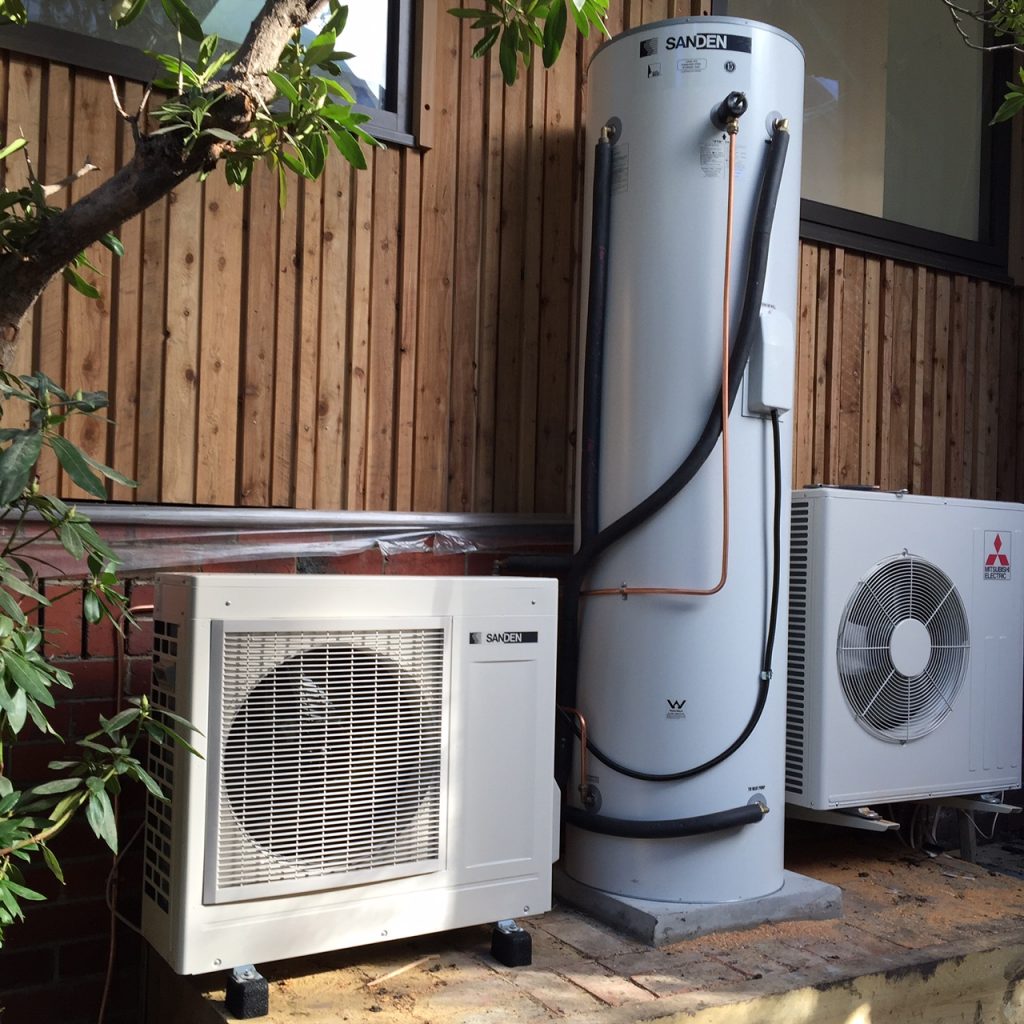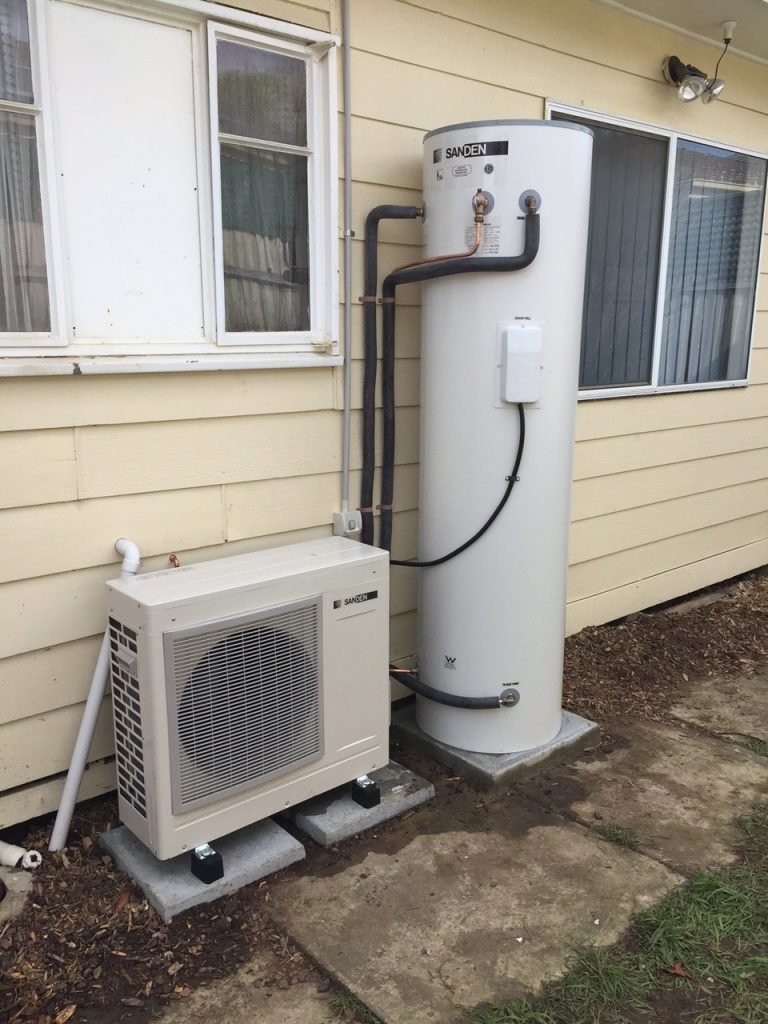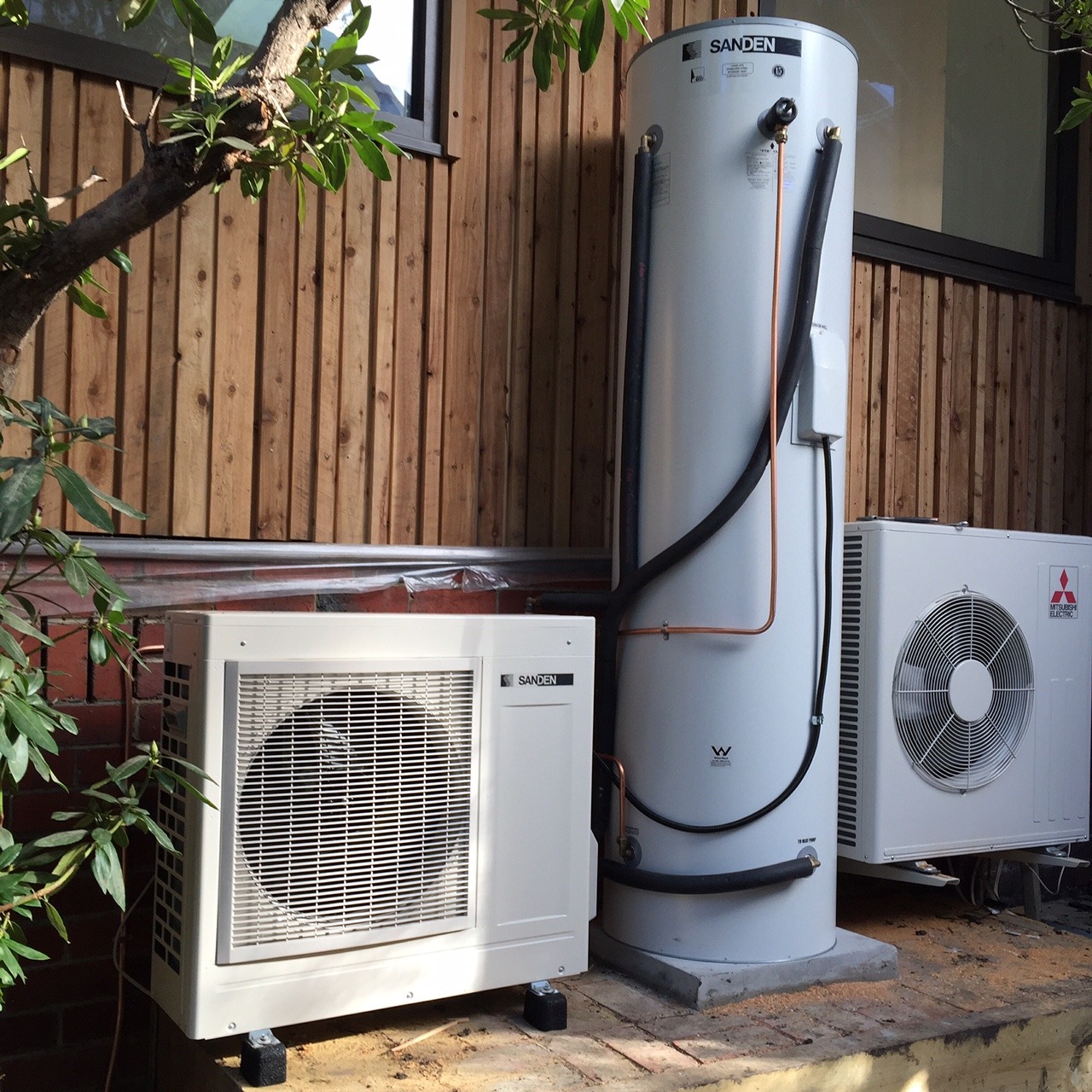
The vast majority of heat pump owners actually put their systems to use in both capacities. Heat pumps are commonly used to heat and cool buildings, but they can also be utilised to heat water independently or in tandem.
The Theory Behind It
In order to heat the water in a storage cylinder, a heat pump(air-to-water) uses thermal energy from the surrounding air. It is also possible to employ a heat source from the ground or water (such as a river or lake), though these are less frequent in New Zealand homes.
An evaporator or heat exchanger receives air from the outside and transfers its heat to the liquid refrigerant. The refrigerant is vaporised and afterwards fed into the compressor. The condenser cools the refrigerant as it heats the water, while the compressor (electrical device) raises the refrigerant’s pressure (and temperature). The refrigerant liquid is condensed and then goes through a control valve to complete the cycle.
Electricity is used by heat pump boilers to transfer heat from one location to another rather than creating heat directly. So they can save as much as three times as much energy as the typical electric resistance water heater. Heat pumps, which are used to relocate heat, function similarly to a fridge in reverse.
In contrast to a refrigerator, which transmits heat out of its inclosure, an air-source heat pump water heater draws heat from the air and transfers it, at a higher temperature, to a storage tank full of water. A heat pump hot water system is available as a packaged whole, complete with a water tank and a secondary heating source (resistance elements) that can be purchased separately. Heat pumps can be installed as an add-on to traditional storage water heaters.
For optimal performance, a heat pump liquid heater should be placed in an area with a constant temperature of between 40 and 90 degrees Fahrenheit (4.4 and 32.2 degrees Celsius) throughout the year and with an air circulation volume of at least a thousand cubic feet all the way around it. Exhaust air from the evaporator could be released either within or outside.
Since heat pumps have a cooling effect on their surrounding environment, they won’t be able to heat the water adequately if installed somewhere chilly.
A room with a furnace is an example of a place with extra heat, making it ideal for installing these devices.
Air-Source
An air-source type heat pump system can be installed for all three heating, cooling, and hot water needs. In the winter, these systems provide warm air from the outside, while in the summer, they bring cool air from within. Any air-source type heat pump system will function better in a warm climate due to the fact that they extract heat from the air.
Geothermal
Geothermal heat pumps are increasingly popular among homeowners as a means of cooling and heating their dwellings. These units take heat from the earth in the winter and the indoor air in the summer. A desuperheater can be added to a geo-heat pumps system to facilitate the heating of water. The water in the desuperheater is heated by the superheated gases that are produced by the heat pump’s compressor. The home’s storage water heater container receives this hot water via a pipe system.
Desuperheaters
There are also desuperheaters available for tankless or demand water heaters. The desuperheater recycles the heat that would normally be wasted during the summer months. The geo heat pump could meet most of your needs for hot water if you run it frequently during the summer.
In the cooler months, whenever the desuperheater isn’t doing its job, you’ll have to depend more on your reserve or demand water heater. As an added bonus, several companies make geo-heat pump systems that may also be used to provide chilled or hot water. In order to supply a home with hot water, they employ a dedicated heat exchanger.
How to Choose a Heat Pump Water Heating Unit
The initial investment for a heat pump water heating system is often greater than that of a traditional storage water heating system. They may be more expensive to buy and set up initially, but their low ongoing expenses make up for it.
The following factors are also important to think about prior to purchasing a heat pump liquid heating system:
- Consistency in size and popularity after the first hour
- Fuel availability and type
- Conservation of energy (energy factor)
- Total expenses
Read up about air-source and ground-source heat pumps if you want a single system to handle your home’s heating, cooling, and domestic hot water needs.
Preparation and Upkeep
To get the most out of your own heat pump liquid heating system’s performance, make sure it’s installed and maintained properly.
There are a lot of variables that must be considered to ensure a successful installation. Fuel type, environment, local building code restrictions, and safety concerns are all examples of such variables. Because of this, it is recommended that a licenced plumber and/or heating contractor (or a geo heat pump systems installer/designer) perform the installation.
Follow these steps to find a reliable expert:
- Seek written confirmation of the estimated price.
- Do a reference check.
- Verify the business’s legitimacy with the BBB in your area.
- Verify that the firm is familiar with and willing to comply with all applicable local ordinances and permits.
Preventative maintenance on your water heater is a great way to keep it running efficiently for a long time. It is recommended that you refer to the owner’s manual for precise upkeep instructions.
Installation
When installing a new heat pump hot water system or adding a split heat pump to a current water storage heater, a construction permit is typically necessary.
No building permit is needed when:
- A certified plumber replaces an old water storage heater with a heat pump hot water storage heater.
- A certified plumber removes and replaces an old indoor water heater with an outdoor heat pump water heater.
- A certified plumber upgrades an existing outside water storage heater to an outside heat pump hot water storage heater.
The system’s external components should be placed so as to promote unrestricted ventilation. If possible, choose a place with mild winters. The outside equipment may turn on at odd hours, so positioning it too close to sleeping quarters could be a problem.
There should be straps connecting the hot-water tank to the building at appropriate anchor points, whether it is located inside or outside. Methods of containment up to 360 litres in capacity are provided under Acceptable Solution G12/AS1. Both the top and bottom straps should be no further than 100 millimetres from the tank’s rim. When carrying a tank with a capacity greater than 200 litres, a third strap should be used to support the middle.
It’s required that an isolation switch be installed on the outside of the house. With the isolation switch, power to the cord can be cut in the event of a break.
For any electrical work to be considered legal, it must be performed by a licenced electrician and accompanied by a current electrical inspection report.
Enhancing Energy Savings
Aside from regular servicing and installation, implementing extra energy-saving measures can further reduce your water heater costs. It can be more cost-effective to implement energy-saving gadgets and systems together with the water heater.
The Effectiveness of Heat Pumps in Heating Water
With a heat pump, electricity is only utilised to transfer the heat, making it the most effective electricity-based water heating solution. They can generate between two and three times as much excess heat for water heating as they consume in power for the pump and fan, giving them a COP of 2.0 to 3.0. In colder climates, heat pump heaters may also use an electric heating element to boost heat production.
As was previously mentioned, low outdoor temperatures lower the effectiveness of heat pumps, especially air-to-water heat pumps.
In order to maximise energy savings, the heat pump system could be put into action during the following:
- When ambient temperatures are higher (as they typically are in the afternoon), the system operates more efficiently.
- Electrical power costs less (for instance, during a night-rate tariff).
- In the event of an overproduction of energy from a solar system, the surplus might be sold back to the utility company.
Air-to-water heat pumps are as efficient as solar water heaters when calculating energy use over a whole year. Because of this, heat pumps are a great option for heating water on sites with low solar gain.
While ground-to-water heat pumps provide a more stable heat source, they are impractical for single-family homes due to their large footprint underground and expensive installation costs, making them better suited for multi-family buildings or extremely cold locations.
Heat losses

Heat pump water heaters, like all storage systems, suffer from “standing losses,” or heat loss through the cylinder’s walls. This implies that they consume power even if you aren’t making use of the hot water they provide. A larger cylinder has a greater surface area to volume ratio, resulting in greater heat loss. Heat losses can account for a significant amount of a home’s total energy expenditure on hot water, especially in smaller homes.
Turning off the heat pump water heater at the main switch will conserve energy if you are going to be absent from home for an extended time.
Electricity Rates at Non-peak Times
You need to size the system such that the volume of water you heat up overnight is sufficient to satisfy your daily demands if you wish to use the heat pump hot water only on the cheaper off-peak energy tariff when it primarily heats the water overnight. Hot water can be wasted if the tank is too small. Talk to the vendor about this when requesting a price.
Set the Timer
In order to regulate the amount of time the heat pump is actively heating water, many models now include a built-in timer. If you’re considering installing a photovoltaic solar (PV) system on your roof, this may be of interest to you. If you utilise a high electricity tariff to power your heat pump water system, you can schedule your daily operations so that you take advantage of the sun’s energy output in the middle of the day.
Setup for a Heat Pump
Heat pump hot water systems can be divided into two categories:
- External, all-in-one integrated systems that comprise a heat exchanger and a storage cylinder.
- Separate from the storage cylinder, split systems house the heat exchanger. It makes no difference whether the cylinder is on the inside or the outside of the structure.
Integrated Systems
The heat pump’s evaporator, compressor, fan, and condenser are typically installed atop the storage cylinder in a system with these components integrated together. The evaporator (which draws heat from the surrounding air) is sometimes placed apart from or wrapped around the storage cylinder. These systems are typically bulkier than split systems because they consist of a single unit.
Split Systems
The components of a split system—evaporator, fan, and compressor—are housed in a separate unit that is refrigerant-piped to the storage cylinder, where the water is heated by passing the hot refrigerant gas through a heat exchanger. They resemble a split-system air conditioner in many ways.
Important Design Choices
Important considerations for heat pump hot water systems include:
- whether or not to employ a modular system
- the heat pump’s capacity and placement.
Carbon Dioxide Heat Pumps
There is a negative environmental impact of heat pumps, despite their energy efficiency: many of them gradually leak refrigerant. Release of even 1 kilogramme of a commonly used hydrofluorocarbon refrigerant into the environment is equivalent to the emission of 1.3 metric tonnes of carbon dioxide.
The availability of air-to-water heat pumps that use carbon dioxide as the refrigerant has significantly mitigated the issue. Compared to CO2, the typical refrigerant R-134a (tetrafluoroethane) used in some New Zealand heat pump water heaters has a GWP of 1300.
